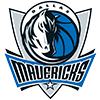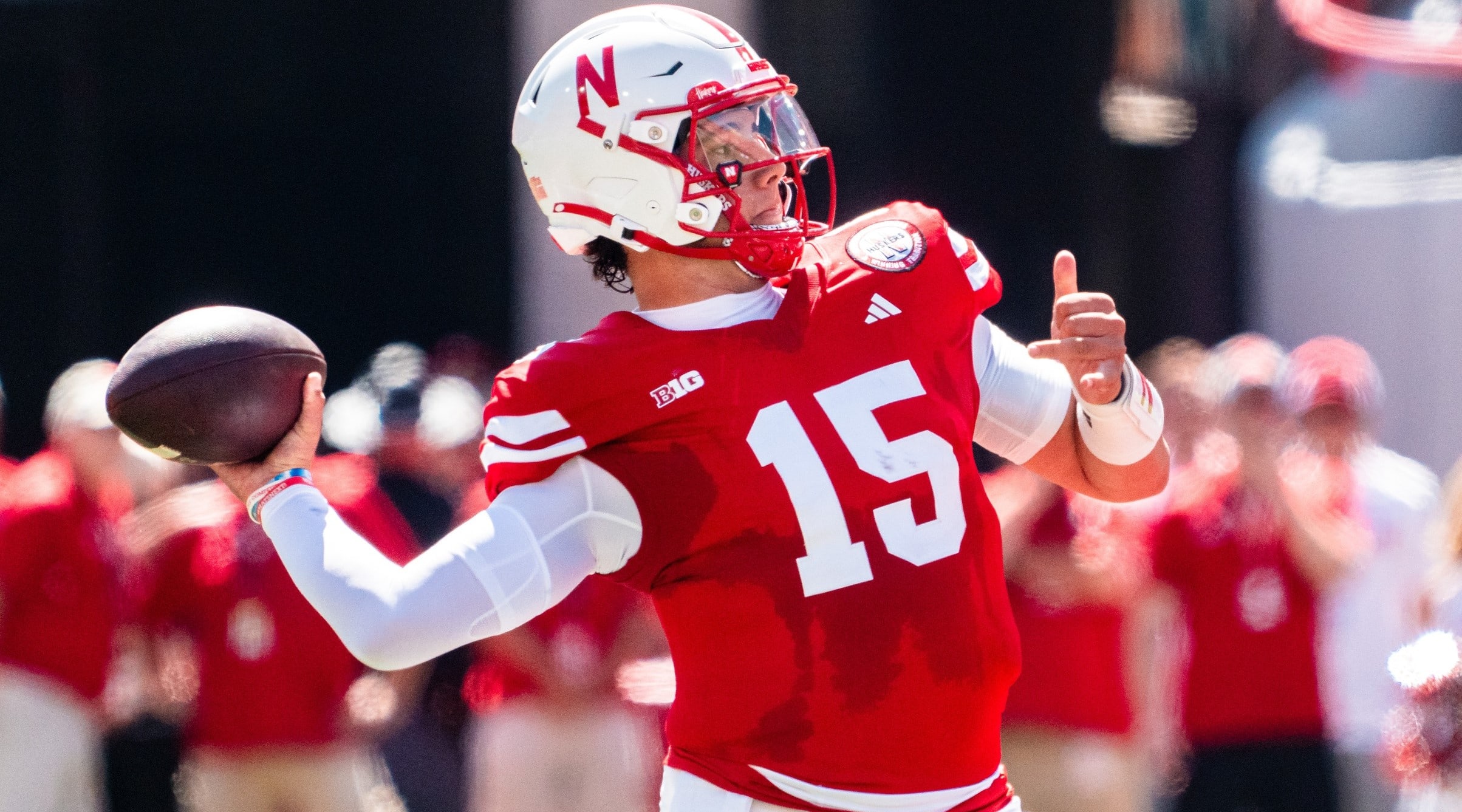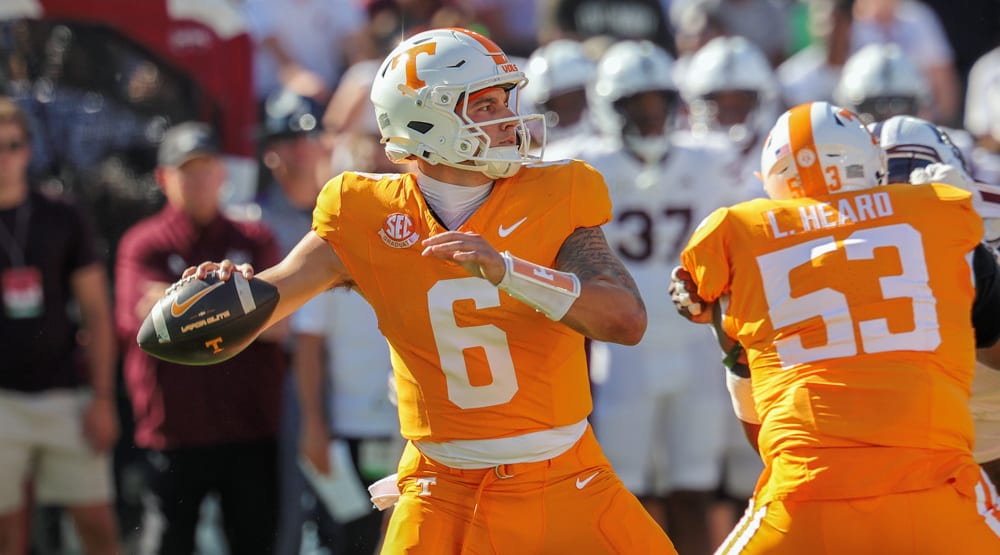Whether you are a CFB veteran or someone just starting to get your feet wet, there are several resources and strategies that will help you pave your way to success in fantasy college football. There are stark differences between the NFL and CFB fantasy products, and your understanding of those differences could be what makes or breaks a lineup.
First, let's highlight the roster construction and a big change DraftKings made to their rosters this year.
Rosters on DraftKings consist of nine players and must include players from at least two different teams. The nine positions are QB, QB, RB, RB, WR, WR, WR, FLEX, FLEX. The major change this year is the addition of the second FLEX spot and the removal of a TE spot. All tight ends are now listed as wide receivers and available in the wide receiver player pool. Tight end has always been a fickle position in college football, as it's typically been the position to "punt," or spend the lowest amount of salary on.
Scoring on DraftKings is in line with most other DFS sites, with the exception of the major difference in that receptions are worth a full point. This scoring will come heavily into play when picking your wide receivers and even your running backs. Another thing to keep in mind are bonuses. Quarterbacks will receive a three-point bonus for passing over 300 yards. Running backs will receive a three-point bonus for rushing over 100 yards. And wide receivers will receive a three-point bonus for accruing over 100 receiving yards.
Now that you have the basics of the roster itself down, it's time to explore how you will pick and choose the nine guys to lead your team.
Vegas
The first stop to make before picking your players is any site that displays Vegas odds and totals, along with team totals.
So if you're looking at Vegas odds for the upcoming matchups, what exactly should you be looking for? High over/under totals with a spread less than 14-to-20 points. These are your prime offensive matchups. These are games that Vegas envisions as offensive shootouts that should remain relatively close. Any over/under of 60 points is a spread that automatically deserves attention. Any spread with an over/under of 70 points should instantly become a target.
Another element to be wary of is the possibility of blowouts. There's a fine line between maximizing a player versus a bad opponent and overspending on a player because he is facing a bad opponent. Nick Chubb may be the best running back available every week, but if Georgia goes up by 30 points at halftime, Chubb may not see the field in the second half. The bigger and better the school, the less likely they are to play their players in blowouts. On the flip side of that, smaller schools will tend to play their starters through a blowout, as they need to manage margin of victory as best as they can to improve their perception.
If you are making a roster decision between two players at a relatively close price point and one plays for a team projected to score 20 points and the other's team is projected to score 35, then you just made a decision easier on yourself.
Checking Rankings
By looking at Vegas lines, you hopefully have eliminated a few teams that you would be targeting. With CFB slates sometimes creeping into the 20-game range, removing a bunch of players right off the bat will make your decisions less overwhelming and allow more time for deeper research. Hopefully, you'll also have a handful of games pegged as ones where you want to target players.
The next item on your list is to check offensive and defensive rankings. I recommend doing a simple search of total offense and total defense numbers first. The NCAA website is a good tool to utilize due to its simplicity and accessibility. This site will give you the total plays ran by an offense, total yards, average yards per play, yards per game, and total touchdowns. By crunching these numbers, you can get a feel of the offenses teams run. The more plays an offense runs, the longer a team will be able to be in possession of the ball. Now, after just one week, these numbers aren't the best or only tool to go off of, but as the season moves on, the data will be more and more beneficial. You can also refer to last year's end-of-season ranks.
You can also search defenses, which will show you the yards allowed per play, how many plays the defense ran, total yards given up, and total yardage. Again, with this being the non-conference part of the season, these numbers will be slightly skewed to reflect the strength or weakness of the opponent.
This is a very broad approach for your research and just a starting point, not an ending point. Remember, no matter what sport you are playing for fantasy, information is key and the more you can take in, the more you are going to get out.
After doing research of a specific team, you will want to break your research down to specific players.
To help you out, look no further than RotoWire's own College Rankings. Rankings for the week will come out every Wednesday and will rank all the major positions. You can combine this with RotoWire's Depth Charts, Injury Reports, and even season-long Cheat Sheets.
Next, research how that player stacks up in their upcoming matchup. Target players that have a significant edge in the offensive ranks and a high ranking team offensive total. You are trying to find the best potential matchup to exploit, while not overspending, and not risking a blowout.
Roster Construction
On DraftKings, you are getting a bit more roster freedom than some other DFS sites. With two quarterbacks and two FLEX spots, there are several different ways to tackle your roster.
Quarterback: Since salaries on DraftKings are often pretty tight, the best strategy is to deploy one high-priced QB and one mid-to-low priced QB. Rostering two high-priced quarterbacks is sometimes a risk worth taking, but you are stretching the rest of your roster very thin.
For your high-priced quarterback, you are going to want to look for one in an elite matchup with a high projected total. You are also going to want to ensure the matchup is one that will keep your quarterback in the whole game, while not risking turnovers or depressed yardage totals against a strong defense. By using that simple criteria, you should be able to narrow down your choices to a small handful of options.
For your mid-to-low priced QB, you are going to use a similar strategy, just at a lower level. This is where name research and understanding of players outside of the Power Five conferences will be beneficial. A strong point to remember in college football is just because you might not know a player or his name, that does not mean that he won't hold value from a fantasy perspective.
Your fantasy points don't always need to come through the air. Plenty of quarterbacks are dual-threat players, so keep in mind rushing ranks while looking at quarterback as well.
Running Back: The running back position has the largest amount of variance in football due to injury and matchup. I rarely recommend spending over $8,000 on a running back on DraftKings unless there is a "can't miss" matchup (but be reminded, there is no such thing as a sure thing). You never want to stretch the rest of your roster too thin just to work in a high-priced running back play. During the week, you will want to be monitoring injury news. If a starting running back is to miss a game, his backup will almost always be very low priced and instantly becomes a strong play.
Wide Receiver: Here is a spot where you can deploy some strategy in pairing up a wide receiver with your quarterback. This is a strategy I use often with my mid-to-low priced QB2, if not both quarterbacks. For example, last week I paired quarterback Jaquez Johnson of Florida Atlantic with his top receiving target in Jenson Stoshak. Stoshak came in with a modest price of $4,400, and coming from a lesser-known school, his start percentage was under 10 percent. Stoshak finished with seven receptions for 114 yards and a touchdown. Johnson finished with 263 yards passing and two touchdowns, including 97 yards on the ground. Both of these players together cost me roughly 20.5 percent of my roster budget, but made up for 24 percent of my total scoring.
It is not always recommended to pair a QB with a WR. Dual-threat quarterbacks are ones you'll want to avoid stacking with since you are hoping for production out of them on the ground. With a fresh season underway, a lot of junior or senior wideouts have moved on, either to the NFL or to graduation. Last year's Nos. 2 and 3 options may be this year's No. 1 option. Pay close attention to those depth charts.
Tight End: As previously mentioned, DraftKings has removed the TE position, adding an extra FLEX position in its place. All tight ends are now listed as wide receivers in the wide receiver player pool. It is not recommended to roster a TE.
Inside the Mind of a DFS Lineup
I am now going to show you my best lineup from last week and dissect my thinking around it.
QB: I paired two quarterbacks going head-to-head in what I projected to be an offensive barnburner. Vegas had the Tulsa/FAU game modestly pegged at 63 for total points scored, but as one of the more competitive games on the slate. Tulsa had a new head coach in Philip Montgomery, who was previously Baylor's offensive coordinator. If you have been around the CFB scene for a while, you know the pace that Baylor has played the last few years, and early reports were that Tulsa was going to try and mimic that tempo. Dane Evans' price of $6,700 was too good to pass up. In my QB2 spot, I was in a similar price situation where I felt I just couldn't pass up Jaquez Johnson at $6,200. His dual-threat ability matched with the thinking that Tulsa would push the pace made Johnson an easy plug in at quarterback.
RB: I started four total running backs, with two being hits, and two being misses. Jalen Hurd was one of my favorite plays on this entire slate. Bowling Green's defense was ranked near the bottom of the NCAA in 2014, and they gave up nearly 200 yards a game on the ground. Hurd's price came in at $6,900, which was right at my level of comfort. Along with Hurd, I targeted Louisville back Brandon Radcliff. The backfield was all his with nothing to make it seem he would be sharing carries with anyone. Auburn was starting junior QB Jeremy Johnson in his first career start, and I didn't envision this game being a blowout. Radcliff was priced at $5,100, and Louisville's passing game ranks near the bottom in the ACC.
On the miss side of the ledger was Texas Tech running back DeAndre Washington. If I can say I got one thing right, it was the fact that Texas Tech scored 59 points. In scoring 59 points, it would be pretty hard to see how one touchdown didn't go to their lead running back, but alas, that was the case. Since he was only $4,500 and in a projected high-scoring affair, I felt he would've sniffed the end zone at least once. Auburn running back Roc Thomas rounded out my running back core. Thomas left the game early with an injury and never returned.
WR: I deployed a double QB-WR stack here with Evans to Keevan Lucas and Johnson to Jenson Stoshak. Lucas was a touted as a top play all week, and it showed by his 44.9 percent start rate. Lucas didn't disappoint his owners (or Dane Evans' owners) in catching 10 balls for 193 yards and two touchdowns. Lucas broke the bank a little bit at $7,800, but he was an investment well made. Stoshak also proved to be a great investment, matching with my QB2 for a touchdown. Jordan Westerkamp rounded out my wideout core with a 38.6% start percentage at his supremely low price tag of $3,900. With Kenny Bell and Ameer Abdullah gone to the NFL, the Nebraska offense was now set to feature Westerkamp as a centerpiece. His price was too low to pass up, and he was a top play in GPP or cash game variants.
One common thing to note between all the games I targeted are the total points: 104, 91, 89, 71, and 54. By targeting games with stronger offenses, I was able to put up 225 fantasy points, which cashed very high in GPPs.
Conclusion
There is no wrong way to assemble a roster, but there are tools and strategies that will give you an edge before hitting the submit button. Follow these four easy steps and you will already have a leg up on competition:
1) Check Vegas totals and narrow down targets
2) Research offensive and defensive ranks, along with team and player ranks
3) Research prices in correlation with your overall roster budget and find value
4) Double check injury reports and depth charts
Along with those four points, RotoWire itself has plenty of tools to help in your roster construction. Head on over to the College Football tab for articles, injury news, suggestions, and rankings.



























